#CIRCA 1ST CENTURY B.C. - 1ST CENTURY A.D.
Explore tagged Tumblr posts
Text

A Roman Bronze Romping Dog Circa 1st Century B.C.-1st Century A.D.
#A Roman Bronze Romping Dog#Circa 1st Century B.C.-1st Century A.D.#bronze#bronze statue#bronze sculpture#ancient artifacts#archeology#archeolgst#history#history news#ancient history#ancient culture#ancient civilizations#ancient rome#roman history#roman empire#roman art#ancient art
1K notes
·
View notes
Text

A Roman Gold Snake Armlet,
Circa 1st Century B.C.-1st Century A.D.
4 3/8 in. (11.3 cm.) wide.
Courtesy: Christies
#art#history#design#style#archeology#sculpture#antiquity#collectors#christie's#snake#bracelet#roman#gold#armlet#1st century#happy new year#lunar new year
728 notes
·
View notes
Text
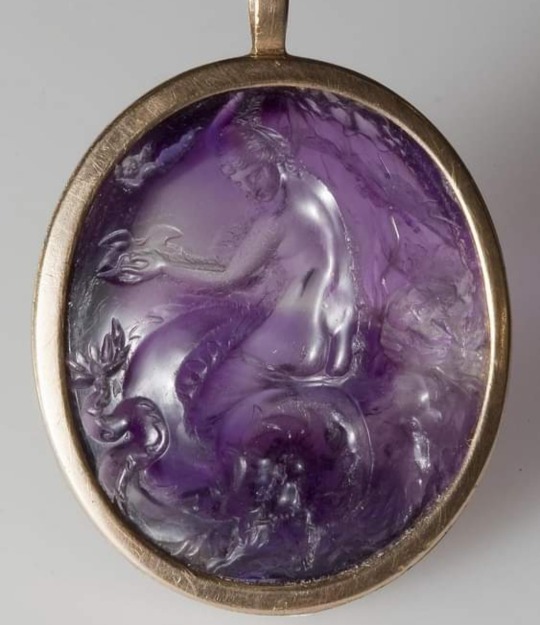
Amethyst Intaglio Circa 1st Century, B.C. - A.D. Roman, Possibly Carved by Master Gem Carver, Dioscurides, Who Was The Favorite Gem Carver Of Emperor Augustus
Source: Archeology and The Ancient Worlds via Facebook/Meta
#amethyst#intaglio#ancient jewelry#precious gemstones#high jewelry#luxury jewelry#fine jewelry#fine jewellery pieces#dioscurides#emperor augustus
484 notes
·
View notes
Text

A ROMAN MARBLE TORSO OF THE DIADUMENOS OF POLYKLEITOS
CIRCA 1ST CENTURY B.C.-1ST CENTURY A.D.
26 notes
·
View notes
Text

Despite what the song says, a kiss isn’t always just a kiss.
A kiss can be political, because it’s the first of its kind or because it’s between two heads of state.
A kiss can also become iconic when it’s captured on film, even if the kiss itself was invasive and unwanted.
With that in mind, here’s a list of some of the most memorable kisses in history.
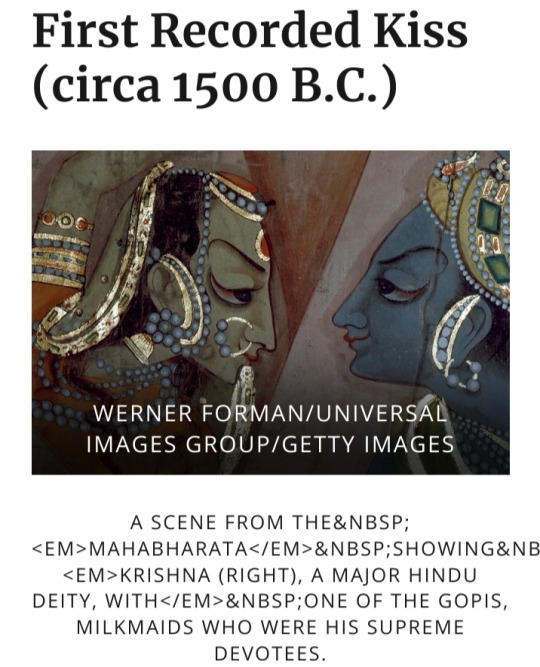
Scholars debate whether kissing began as a trend that spread around the globe, or sprung up organically in different regions.
Whatever the case, the earliest known written mentions of it are in Vedic Sanskrit scriptures circa 1500 B.C., according to research by Vaughn Bryant, an anthropology professor at Texas A&M University.
These scriptures, known as the Vedas, were foundational to the religion of Hinduism.
After that, kissing continued to appear in ancient Indian and Hindu literature.
The Mahabharata, a Sanskrit epic compiled by the 4th century A.D., has a line in which someone “set her mouth to my mouth and made a noise that produced pleasure in me.”
The Kama Sutra, an ancient Sanskrit text on eroticism and love, also has a chapter on kissing that identifies different methods of kissing and types of kisses.
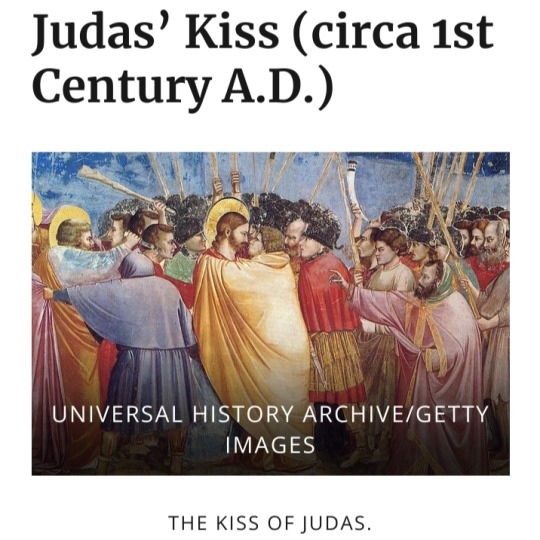
Kissing isn’t just a romantic act. It can also be a sign of friendship or betrayal.
In the Gospels of Matthew and Mark, written circa the 1st century, Judas betrays Jesus by identifying him with a kiss so that armed men can take him away and eventually kill him.
Judas’ kiss has since become a popular storytelling allusion.
It may have inspired the “kiss of death” that appears in mafia literature and film (but was probably never an actual mafia practice).
Perhaps the most famous example is in The Godfather Part II, when Al Pacino’s character gives his brother Fredo the kiss of death for betraying him.
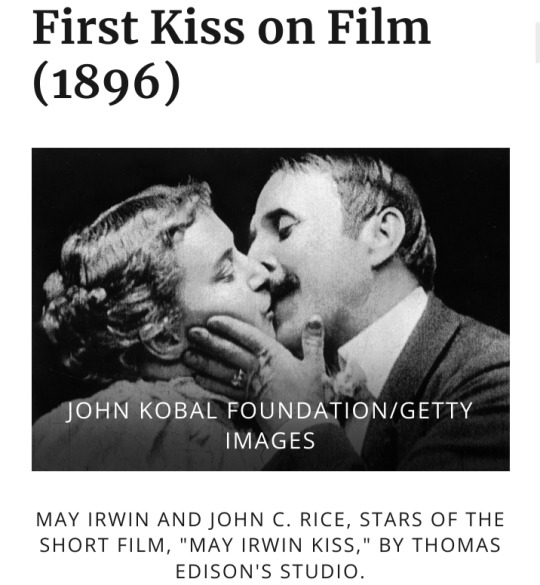
The first people to smooch on film were May Irwin and John C. Rice, who appeared in a short film known variously as May Irwin kiss, Kiss, or The Kiss.
In 1896, the two performers went to Thomas Edison’s studio in New Jersey and reenacted their final kiss scene from a play they were putting on in New York City.
On stage, no one thought the kiss was that sensational. But many felt the close-up footage of them kissing was too risqué.
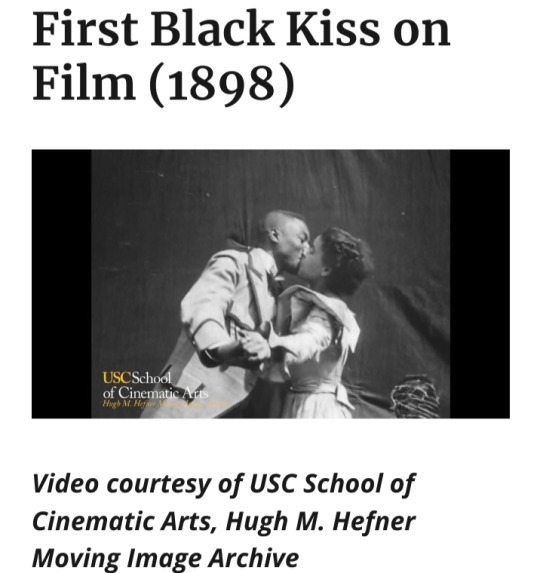
In 1898, black performers Saint Suttle and Gertie Brown starred in a short film titled ''Something Good-Negro Kiss,'' the first film to show Black Americans kissing.
In 2017, film historians rediscovered the footage, which was filmed by a white man named William Selig in Chicago.
“There’s a performance there because they’re dancing with one another, but their kissing has an unmistakable sense of naturalness, pleasure and amusement as well,” Allyson Nadia Field, a professor of cinema and media studies at the University of Chicago who helped identify the film, said in a university press release.
“It is really striking to me, as a historian who works on race and cinema, to think that this kind of artifact could have existed in 1898.”
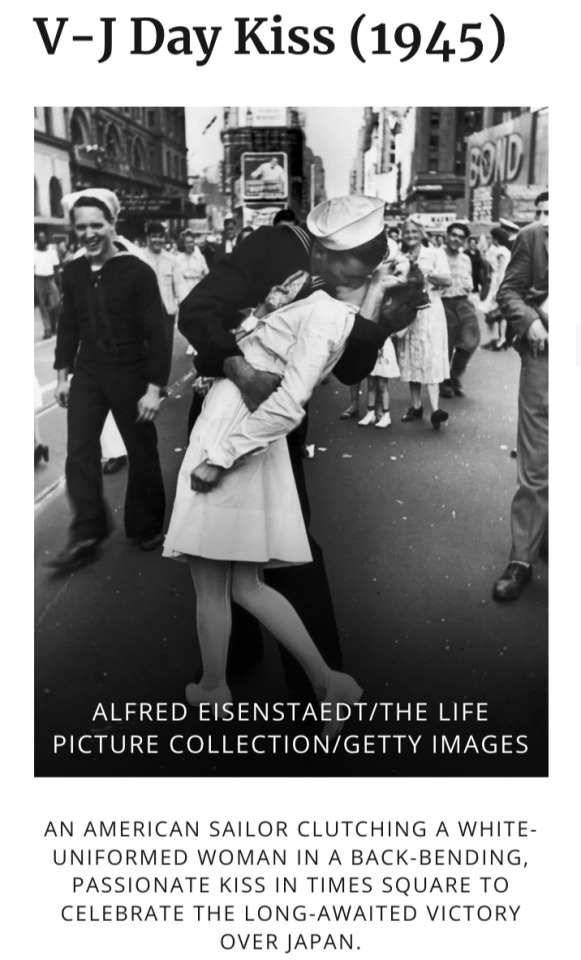
On the morning of 14 August 1945, patients burst into Greta Zimmer’s Manhattan office claiming the war in Japan was over.
The Austrian immigrant wasn’t sure what to think, so on her lunch break, she went to Times Square in her white dental assistant’s uniform to see what the news ticker said.
The atmosphere there was celebratory. The ticker confirmed that it was indeed V-J Day, and World War II was over.
As Zimmer looked away from the ticker, a Navy sailor named George Mendonsan — who’d started drinking early and mistook Zimmer for a nurse — ran up and aggressively kissed her, leaving his girlfriend behind.
Zimmer struggled to push the stranger off, and they parted ways.
But unbeknownst to both of them, photographers Alfred Eisenstaedt and Victor Jorgensen had each captured the moment, as recounted in The Kissing Sailor: The Mystery Behind The Photo That Ended World War II.
Eisenstaedt’s photo became one of the most iconic WWII images in U.S. history, in part because viewers mistook it for a picture of a Naval officer and nurse celebrating together.
The photo has also stirred controversy, as many people have claimed over the years to be the couple in the image, while others point out that it depicts a nonconsensual moment.
Zimmer said in an interview with the Library of Congress in 2005:
“It wasn’t my choice to be kissed...the guy just came over and kissed or grabbed!”

When William Shatner and Nichelle Nichols kissed on a 1968 episode of Star Trek, it was not technically the first interracial kiss on U.S. television.
But it was the one that seemed to have the most cultural impact.
In the episode, titled “Plato’s Stepchildren,” Captain James Kirk and Officer Nyota Uhura encounter aliens who force them to kiss each other through telekinesis.
In Nichols’ book Beyond Uhura: Star Trek and Other Memories, she recalls that NBC was worried how white Americans would react to the scene, so they asked the actors to film two scenes: one with a kiss and one without a kiss.
However, Nichols and Shatner purposefully messed up all of the kissless takes in order to ensure that NBC aired the kissing scene.

During the Cold War, leaders of communist states often greeted each other with what’s called the “socialist fraternal kiss.”
This could be on the cheek or the mouth, but the most famous example is French photographer Régis Bossu’s 1979 picture of the Soviet Union’s Leonid Brezhnev and East Germany’s Erich Honecker kissing on the mouth.
The kiss occurred when Brezhnev visited East Berlin to celebrate the 30th anniversary of the German Democratic Republic (i.e., East Germany).
When the Berlin Wall came down in 1989, the Soviet artist Dmitri Vrubel recreated the image in a mural on the wall’s east side.
He captioned it: “My God, Help Me to Survive This Deadly Love.”
#Memorable Kisses in History#kiss#history#Vedic Sanskrit scriptures#Vedas#The Mahabharata#The Kama Sutra#Judas#Jesus#May Irwin#John C. Rice#Saint Suttle#Gertie Brown#William Selig#Greta Zimmer#Alfred Eisenstaedt#Victor Jorgensen#V-J Day#World War II#Star Trek#William Shatner#Nichelle Nichols#Socialist Fraternal Kiss#Régis Bossu#Leonid Brezhnev#Erich Honecker#German Democratic Republic#Berlin Wall#Dmitri Vrubel#Judas Kiss
5 notes
·
View notes
Text
An Ancient Roman Bust Purchased for $35 at a Texas Thrift Store Is Now Being Repatriated to Germany
Currently on view at the San Antonio Museum of Art, the sculpture will be returned to the Pompejanum in Germany later this year.
— Taylor Dafoe | April 18, 2023 | News Art Net
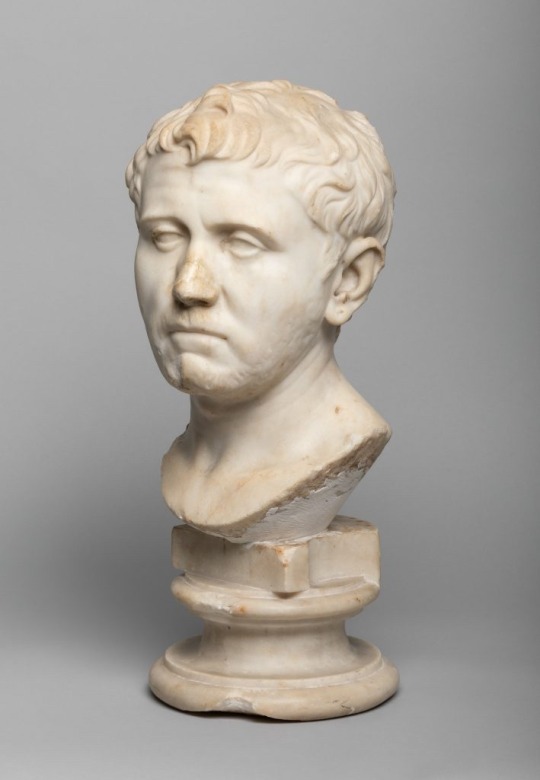
Portrait of a man, Roman, circa late 1st century B.C. or early 1st century A.D. Courtesy of the San Antonio Museum of Art.
Five years ago, an eagle-eyed thrift store owner named Laura Young picked up what turned out to be an ancient Roman bust at a Goodwill in Austin, Texas. Now the sculpture is headed back to Germany, from where it last came.
The marble bust is believed to have been created in the late 1st century B.C.E. or early 1st century C.E. Though Italian in origin, the last-known record of the piece traces it back to the Pompejanum, a full-scale replica of a Pompeii villa commissioned in the 1840s by King Ludwig I of Bavaria.
Located in the German city Aschaffenburg, the Pompejanum faced heavy bombing during World War II. The site was restored and reopened in the 1960s, but by that time, or perhaps shortly after, the bust had disappeared. Some suspect it may have been taken by a U.S. soldier stationed in the area.
For the last year, the sculpture has been on view at the San Antonio Museum of Art, which has worked with Young and the Bavarian Administration of State-Owned Palaces to return the piece.

Portrait of a man, Roman on view at the San Antonio Museum of Art. Courtesy of SAMA.
The bust will be removed from display on May 21, after which time it will be repatriated to Germany. “Upon its return, the portrait will either go back on display in its original location at the Pompejanum in Aschaffenburg, or at the Munich Glyptothek with the rest of Ludwig I’s collection,” a spokesperson for the museum told Artnet News. The representative declined to comment when asked whether SAMA or the Bavarian Administration of State-Owned Palaces will pay for the sculpture’s shipping and insurance.
“It’s a great story whose plot includes the World War II era, international diplomacy, art of the ancient Mediterranean, thrift shop sleuthing, historic Bavarian royalty, and the thoughtful stewardship of those who care for and preserve the arts, whether as individuals or institutions,” said Emily Ballew Neff, SAMA’s director, in a statement last year.
She called the museum’s work with the Bavarian Administration of State-Owned Palaces “a wonderful example of international cooperation. This is another critical way in which our art museums participate in diplomacy around the globe.”

Laura Young with the portrait of a man. Photo courtesy of Laura Young.
Young, who operates a company called Temple of Vintage, paid just $34.99 for the bust at Goodwill, but even then, she suspected it may be worth much more. That inkling led her to get in touch with University of Texas scholars and auction house experts. After four years, Young finally confirmed the artwork to be authentic.
By that point, though, she knew she had to give it up.
“My husband and I were on a road trip when I got an email from Bonhams confirming the head was indeed ancient Roman, but without provenance they could be of no further assistance. Soon after that, Sotheby’s got in touch,” Young recalled. “There were a few months of intense excitement after that, but it was bittersweet since I knew I couldn’t keep or sell the [bust].”
Who exactly the sculpture is meant to depict remains unclear. Experts have suggested that the visage belongs to Sextus Pompey, a military leader who fought and lost to Julius Caesar before being executed. Others believe the bust was based on the Roman politician Nero Claudius Drusus Germanicus.
“Either way, I’m glad I got to be a small part of [the sculpture’s] long and complicated history,” Young continued, “and he looked great in the house while I had him.”
— Taylor Dafoe, News and Features Writer
0 notes
Photo

ROMAN BRONZE OPENWORK HARNESS MOUNT -CIRCA 1ST CENTURY B.C.-2ND CENTURY A.D.
447 notes
·
View notes
Text

Fragmentary Roman marble head of a Young God or Ruler, circa 1st Century A.D.
Dated as early as 300 B.C., the marble bust of Alexander the Great portrays Alexander as Helios, a Greek mythological god of the sun. The ancient fragment of the bust was excavated in the early 1900s.
#alexander the great#helios#roman#marble#head#bust#sculpture#young#god#ruler#art#alexander#history#europe#european#ancient#antiquity#classical#sun#greek mythology#sculptures#augustan#italy
41 notes
·
View notes
Photo

A Roman Banded Agate Amphoriskos , circa: 1st Century B.C. - 1st Century A.D. Private Collection.
2 notes
·
View notes
Text
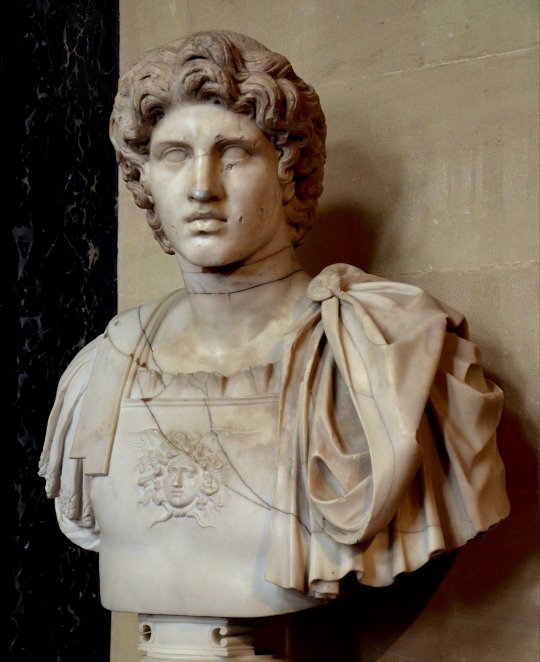
Roman bust of Alexander the Great, excavated from the ruins of Herculaneum.
-Blenheim Palace Oxfordshire, UK.
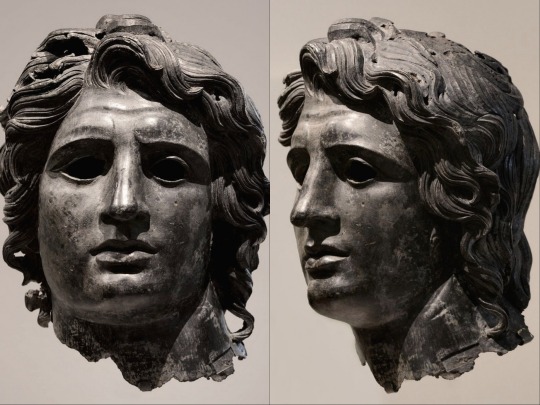
Bronze portrait of Alexander the Great. Greek or Roman, Late Hellenistic to Hadrianic ca. 150 B.c. - A.D. 138.
This posthumous portrait, with long "leonine" hair recalling Alexander's divine association with the hero Herakles, was probably from a cult statue.
-Metropolitan Museum of Art, NYC.
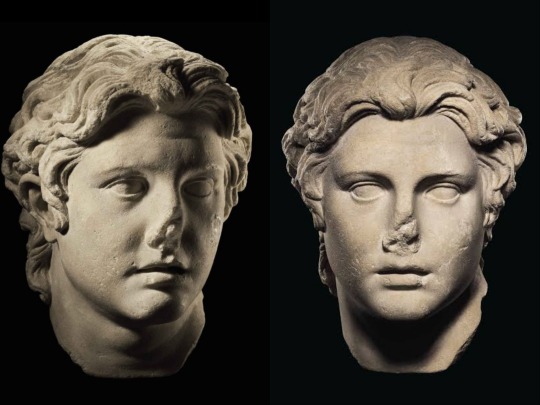
A Roman marble portrait of Alexander the Great. Circa 1st century AD.
The Macedonian ruler depicted lifesized, with a muscular neck, the laryngeal prominence bulging, his head turned to his right, his forehead creased, the deep-set eyes with modeled lids, his small mouth with parted lips, his thick, leonine hair swept up at the forehead in characteristic anastole.
-Antiquities, Sotheby's, London.
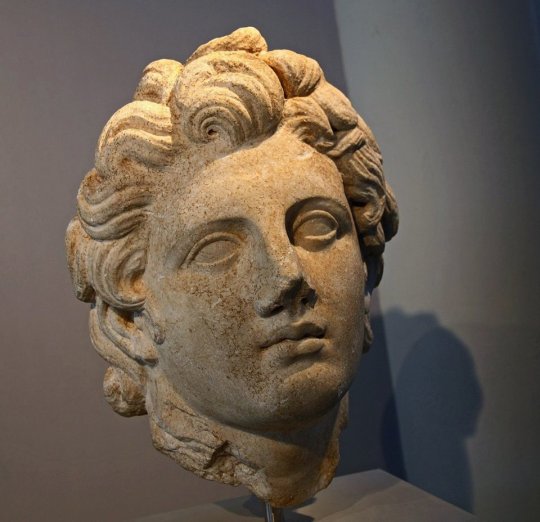
Marble head of a statue of Alexander the Great from the Court of the Passage of the Theoroi, Thasos, Greece. 2nd century AD.
Thasos was one of the first cities to worship Alexander as a god. An annual Alexandreia festival was held there on his birthday. This head features one of the most obvious examples of the "anastole" hairstyle characteristic of several portraits of Alexander.
-Thasos Archaeological Museum.
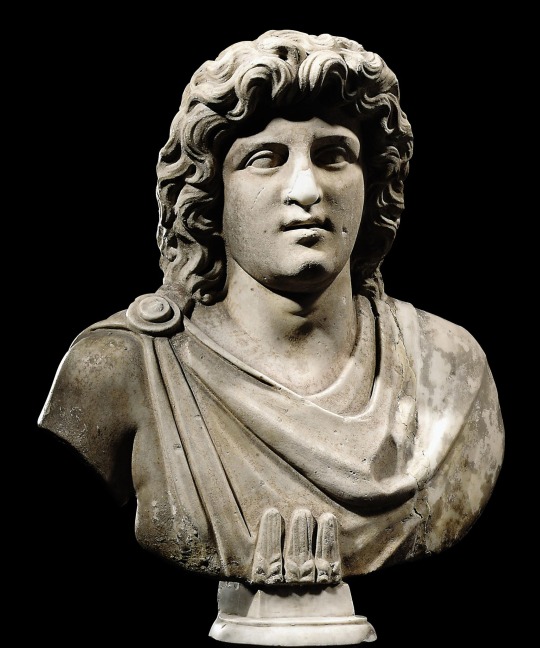
A Roman marble bust of Alexander Helios. Circa 1st Century AD.
His face framed by thick wavy hair, with seven recesses over the top of the head for insertion of bronze rays, wearing a chlamys fastened with a circular brooch at the shoulders, with three ears of wheat at the base of the bust, mounted.
-Formerly in a Swiss private collection, 1950s.
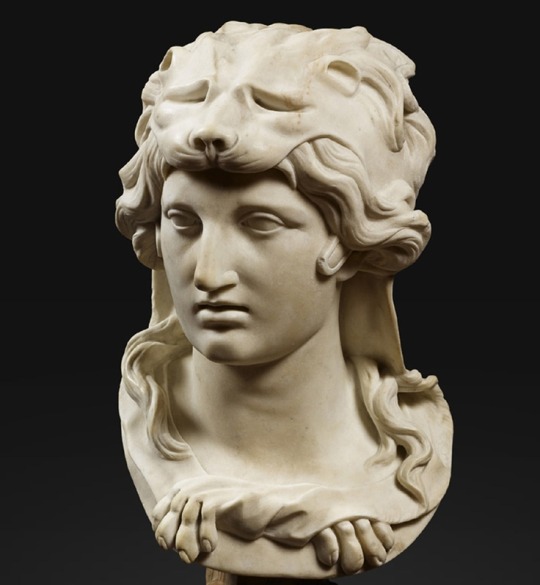
Bust of Alexander the great – Pierre II Legros known as Le Jeune.
This marble bust depicts Alexander the Great wearing a helmet reminiscent of his status of chief of the Macedonian armies. Wrapped in a lion’s skin, an attribute of Heracles, he also measures up to the twelve labors of this half mortal and half-deity hero, in light of his multiple military triumphs.
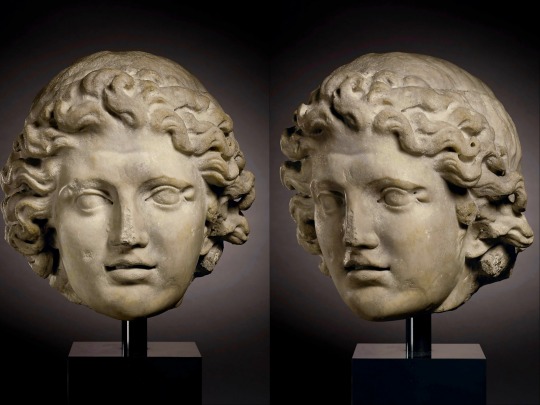
A monumental Roman marble head portrait of Alexander the Great.
Late Antonine period to early Severan period, circa late 2nd - early 3rd century AD.
-Marbury Hall, Cheshire, UK.
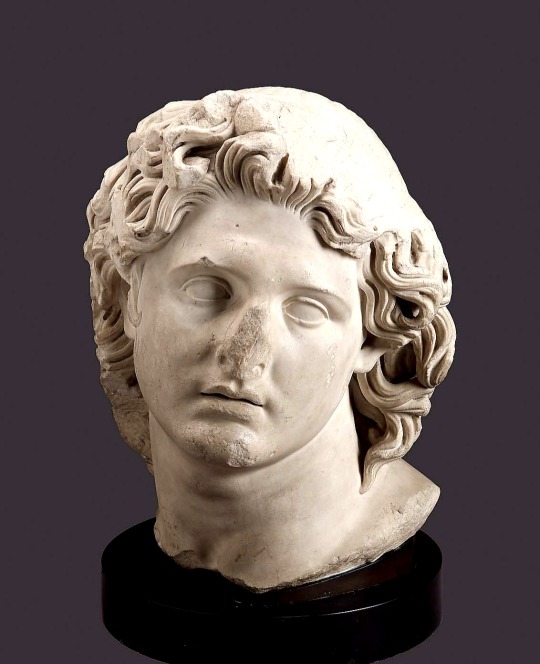
Head of Alexander the Great as Helios, Roman 2nd century AD.
Turned violently upward and to its own left, this head of Alexander the Great as Helios was carved to be let into a statue of nearly colossal proportions. The divine ruler was probably represented in the heroic nude with a cloak or aegis about the shoulders, concealing the join of the neck and shoulders. A ruler's rolled fillet encircles the head behind the leonine locks which enframe the face.
-Museum Of Fine Arts Boston.
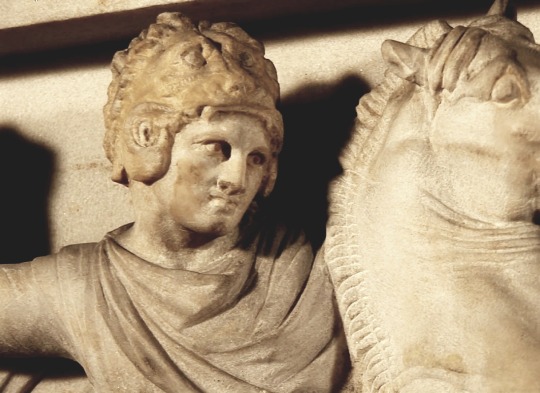
A detail of the relief on one of the long side of the Alexander sarcophagus. We see Alexander at the Battle of Issus (333 BC).
The King is shown wearing a lion-shaped helmet, which is perhaps a reference to Heracles, the hero who defeated the Nemean Lion, or otherwise serves to underscore his ferocity in battle.
-Istanbul Archaeological Museum.

Alexander the Great wearing a lion skin, a frequent attribute on monetary portraits alluding to Herakles, his mythical ancestor; inscribed letters on the face are later additions.
Pentelic marble, ca. 300 BC. Found in Kerameikon, Athens.
-National Archaeological Museum of Athens.
25 notes
·
View notes
Photo


Two fragmentary Egyptian Mosaic Glass Theatre Masks Inlays Roman Period, circa 1st Century B.C.-1st century A.D. / (2.5 cm. and 3.1 cm.) high
via: Christie’s
70 notes
·
View notes
Text



A Romano-Egyptian Faience Inkwell Circa 1st Century B.C.-2nd Century A.D.
#A Romano-Egyptian Faience Inkwell#Circa 1st Century B.C.-2nd Century A.D.#stoneware#blue#ancient artifacts#archeology#archeolgst#history#history news#ancient history#ancient culture#ancient civilizations#ancient rome#roman history#roman empire
194 notes
·
View notes
Photo

A Sarmatian gold lion griffin head appliqué,
Circa 2nd century B.C./1st century A.D.
Northern Black Sea or Central Asian Steppes,
Repoussé and with turquoise and enamel inlays over A black substance, probably bitumen.
Lenght 4.5 cm., depth 1.5 cm.
Sotheby’s
#art#sculpture#lion#head#griffin#sarmatian#black sea#asia#repoussé#turquoise#gold#bitumen#sotheby's#luxury lifestyle#antiquity#archeology#2nd century BC#1st century A.D.#collectors#enamel
134 notes
·
View notes
Photo

A Graeco-Roman gold snake ring, circa 1st century B.C.-1st century A.D.
0 notes
Photo

Terracotta Plaque, Early Roman Imperial, Circa late 1st Century B.C./1st half of the 1st Century A.D.
Finely modeled in shallow relief with two ladies walking to right, each personifying a season, Summer holding a garland in her right hand and poppies and sheafs of wheat in her left hand, Spring holding a kid in her right hand and a basket of fruit in her left hand.
36 notes
·
View notes
Photo

Qatabānic inscription on South Arabian alabaster funerary stele, circa 1st century B.C. - 1st century A.D.
2 notes
·
View notes